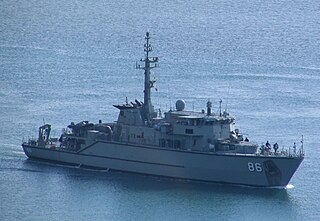
HMAS Leeuwin is the lead ship of the Leeuwin-class of hydrographic survey vessels operated by the Royal Australian Navy (RAN).

The Huon-class minehunter coastal (MHC) ships are a group of minehunters built for the Royal Australian Navy (RAN). Following problems with the Bay-class minehunters, a request for tender was issued in 1993 for a class of six coastal minehunters under the project designation SEA 1555. The tender was awarded in 1994 to the partnership of Australian Defence Industries (ADI) and Intermarine SpA, which was offering a variant of the Italian Gaeta-class minehunter.

HMAS Huon, named for the Huon River, is the lead ship of the Huon class of minehunters operated by the Royal Australian Navy (RAN). The first of six ships built by a joint partnership of Australian Defence Industries (ADI) and Intermarine SpA, Huon's hull was fabricated at Intermarine's Italian shipyard, then freighted to ADI facilities at Newcastle for completion. She entered service in 1999.
HMAS Shepparton is a Paluma-class survey motor launch of the Royal Australian Navy (RAN).

The Leeuwin class is a two-ship class of hydrographic survey vessels operated by the Royal Australian Navy (RAN). Leeuwin and Melville were ordered from NQEA Australia in 1996, and were commissioned in 2000. The ships are capable of charting waters up to 6,000 metres (20,000 ft) deep, carry three Fantome-class survey boats, and can operate an AS 350B Squirrel helicopter. In addition to surveying duties, since 2001 both vessels have been used to supplement the RAN patrol force. Leeuwin and Melville are based at HMAS Cairns, and are active as of 2023.

HMAS Diamantina, named after the Diamantina River, is a Huon-class minehunter currently serving in the Royal Australian Navy (RAN). Built by a joint partnership between Australian Defence Industries (ADI) and Intermarine SpA, Diamantina was constructed at ADI's Newcastle shipyard, and entered service in 2000.

HMAS Wewak was the fifth ship of the Balikpapan class of heavy landing craft operated by the Royal Australian Navy (RAN).

HMAS Melville is the second ship of the Leeuwin class of hydrographic survey vessels operated by the Royal Australian Navy (RAN).

HMAS Norman, named for the Norman River in Queensland, is the third Huon-class minehunter to serve in the Royal Australian Navy (RAN). Built by a joint partnership between Australian Defence Industries (ADI) and Intermarine SpA, Norman was constructed at ADI's Newcastle shipyard, and entered service in 2000.

HMAS Paluma is the lead ship of the Paluma-class survey motor launches operated by the Royal Australian Navy (RAN).
HMAS Mermaid is a Paluma-class survey motor launch serving in the Royal Australian Navy (RAN).

HMAS Gascoyne, named for the Gascoyne River, is the fourth of six Huon-class minehunters constructed for and currently in service with the Royal Australian Navy (RAN). Built by a joint partnership between Australian Defence Industries (ADI) and Intermarine SpA, Gascoyne was constructed at ADI's Newcastle shipyard, and entered service in 2000.

HMAS Hawkesbury, named for the Hawkesbury River, is the second Huon-class minehunter to have been built for the Royal Australian Navy (RAN). Built by a joint partnership between Australian Defence Industries (ADI) and Intermarine SpA, Hawkesbury was constructed at ADI's Newcastle shipyard, and entered service in 2000.

HMAS Yarra is the sixth Huon-class minehunter to have been built for the Royal Australian Navy (RAN) and the fourth warship to be named after the Yarra River in Victoria. Built by a joint partnership between Australian Defence Industries (ADI) and Intermarine SpA, Yarra was constructed at ADI's Newcastle shipyard, and entered service in 2003.

The Paluma-class motor launch was a class of four hydrographic survey motor launches operated by the Royal Australian Navy (RAN). Built in Port Adelaide between 1988 and 1990, the four catamarans were primarily based at HMAS Cairns in Cairns, Queensland, and operated in pairs to survey the waters of northern Australia.

The Fantome class is a class of eight small survey motor boats (SMBs) operated by the Royal Australian Navy (RAN) and DMS Maritime. The four-man boats are designed to operate from the Leeuwin-class survey vessels, with three assigned to each ship, while the seventh and eighth were attached to the RAN Hydrographic School at HMAS Penguin. They are fitted with navigational and survey equipment and are unarmed.
TRV Tuna (801) was one of three Torpedo Recovery Vessels operated by the Royal Australian Navy (RAN) and Defence Maritime Services (DMS). Ordered in 1969, the vessel, originally identified as TRV 253, was completed in 1970 and assigned to the torpedo firing range at Jervis Bay. The ship received a name and the pennant number "TRV 801" in 1983. In 1988, the three vessels were sold to DMS. Tuna was assigned to the naval base at HMAS Creswell in Jervis Bay. Tuna was active in DMS service as of 2007.
TRV Trevally (802) was one of three Torpedo Recovery Vessels operated by the Royal Australian Navy (RAN) and Defence Maritime Services (DMS). Ordered in 1969, the vessel, originally identified as TRV 254, was completed in 1970 and assigned to the naval base HMAS Waterhen in Sydney. The ship received a name and the pennant number "TRV 802" in 1983. In 1988, the three vessels were sold to DMS. Trevally remained at Waterhen under DMS control. Trevally was active in DMS service as of 2007.
TRV Tailor (803) was one of three Torpedo Recovery Vessels operated by the Royal Australian Navy (RAN) and Defence Maritime Services (DMS). Ordered in 1969, the vessel, originally identified as TRV 255, was completed in 1971 and assigned to the naval base HMAS Waterhen in Sydney. The ship received a name and the pennant number "TRV 803" in 1983. In 1988, the three vessels were sold to DMS. Tailor was assigned to the naval base HMAS Creswell in Western Australia. Tailor was decommissioned in 2018.
The Fish class was a ship class of three torpedo recovery vessels previously operated by Defence Maritime Services (DMS).













